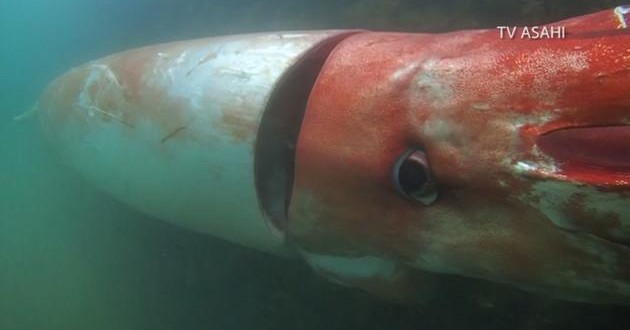Japan – Giant squid fans got a nice Christmas present, when one of the titans of the deep appeared in a Japanese harbor on Christmas Eve.
It was a rare sight to behold and has given scientists an insight into the giant squid which they know little about.
The 3.7 metre-long creature surfaced in Toyama Bay in central Japan on Christmas Eve and was lurking around the harbour for several hours before it went back into the ocean depths, CNN reports.
The cephalopod was relatively small compared to the 13 metres they’re known to grow to, which has led to speculation it could be a juvenile.
Local dive shop owner Akinobu Kimura swam near the cephalopod. The encounter was filmed using a submersible camera.
He says he got into the water with the creature because his curiosity was “way bigger than fear” and it got the better of him.
“This squid was not damaged and looked lively, spurting ink and trying to entangle his tentacles around me. I guided the squid toward to the ocean, several hundred meters from the area it was found in, and it disappeared into the deep sea,” he told CNN
There were 16 reports of the giant squid trapped in fishing nets last season, which runs from November to March, and this is the first sighting this season.
https://www.youtube.com/watch?v=ojrrBsmLqn8
Giant squid live up to their name: the largest giant squid ever recorded by scientists was almost 43 feet (13 meters) long, and may have weighed nearly a ton. You’d think such a huge animal would be hard to miss. But because the ocean is vast and giant squid live deep underwater, they remain elusive and are rarely seen: most of what we know comes from dead carcasses that floated to the surface and were found by fishermen.
The giant squid is not just a single species — or is it? Some researchers think there are as many as 8 species in the genus Architeuthis (Greek for “chief squid”), each a different kind of giant squid. But other researchers think there is just one Architeuthis that swims in the world’s ocean. There is no consensus because the squid are so hard to track and there are so few specimens available for study.
However, it is certain that Architeuthis has an abundance of evolutionary relatives. The ocean holds an estimated 500 species of squid—and almost all of those are in the same taxonomic order as the giant squid, called Oegopsina. Some are surprisingly tiny—only about 1 inch (2.5 centimeters) in length. Others are impressively large, including the the colossal squid (Mesonychoteuthis hamiltoni), which can grow to be even bigger than the giant squid, reaching 45 feet (14 meters).
These squid species are closely related to snails, clams, and even slugs: they are all mollusks, which are defined by their soft bodies. Some of these soft bodies are encased in hard shells, such as clams and snails, but not the squids.
Squids belong to a particularly successful group of mollusks called the cephalopods, which have been around for about 500 million years. Some ancestors of modern-day squids had shells, such as the ammonites, which ruled the waves 400-65 million years ago. Of those that are still around, one small group—the nautiluses—has an external shell. The other—which includes squids, cuttlefishes, and octopods—does not, although squids and cuttlefishes have an internal, backbone-like support made of chitin called a pen.
Shell or no shell, all cephalopods have well-developed brains and are very active, jet propelling themselves through the ocean. Most have ink sacs. And many can change skin color and texture in the blink of an eye.
Agencies/Canadajournal
 Canada Journal – News of the World Articles and videos to bring you the biggest Canadian news stories from across the country every day
Canada Journal – News of the World Articles and videos to bring you the biggest Canadian news stories from across the country every day



